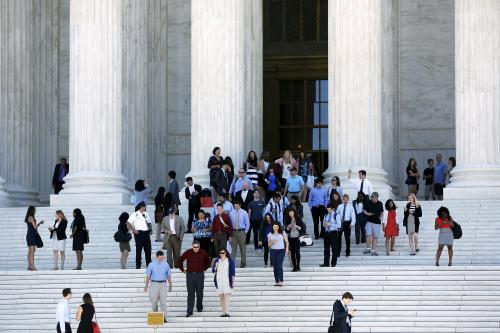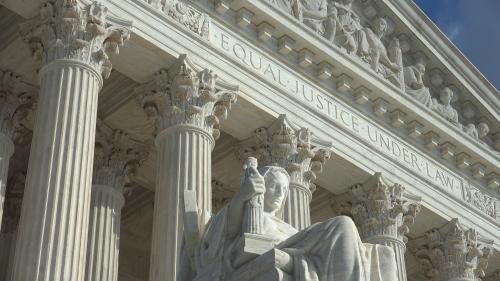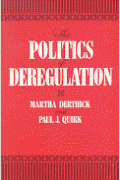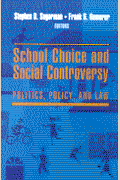Brett Kavanaugh, President Trump’s nominee to replace retiring Supreme Court justice Anthony Kennedy, is less likely to override Roe v. Wade than to rein in the agencies at the heart of the modern administrative state. Here’s why:
During the 1930s, President Franklin Roosevelt proposed—and the Congress ratified—the creation of new agencies to help implement the expansive legislation at the heart of the New Deal. After years of bipartisan fact-finding and deliberation, Congress codified the activities of the agencies in the Administrative Procedure Act (1946), which sets forth the processes through which regulations and other forms of legislative implementation may proceed.
This statute gives formal and, in the eyes of many, quasi-constitutional status to the modern administrative state. It also raises enduring questions about the relationship between agencies and the three constitutionally established branches of government. For example, when an agency claims authority to promulgate a regulation, who has the power to limit the exercise of this authority? When someone takes an agency to court asserting that a regulation lacks legislative justification, what standards should the courts use to weigh this claim?
Nearly a quarter of a century ago, in Chevron v. NRDC (1984), the Supreme Court offered a clear answer: unless Congress has spoken clearly on the subject of a regulation, the courts should defer to an agency’s decision as long as it is reasonable, even if the courts would have reached a different interpretation. Whenever a statute is ambiguous, the agency enjoys wide discretion. Anything that is not unreasonable lies in the zone of the permissible.
As both an appellate judge and legal commentator, Mr. Kavanaugh has been critical of this decision. In a 2016 article in the Harvard Law Review, he states that Chrevron “has no basis in the Administrative Procedure Act” and represents “an atextual invention by courts.” In fact, he adds, the decision is “nothing more than a judicially orchestrated shift of power from Congress to the Executive Branch.”
Mr. Kavanaugh objects not only to the jurisprudence underlying the decision, but also to its consequences. “From my more than five years of experience in the White House,” he declares, “I can confidently claim that Chevron encourages the Executive Branch (whichever party controls it) to be extremely aggressive in seeking to squeeze its policy goals into ill-fitting statutory authorizations and restraints.”
In short, this decision unleashes presidents’ incentives to push their executive authority to the limit, often beyond. The reason, Kavanaugh says, is rooted in today’s partisan and legislative gridlock: “Presidents run for office on policy agendas and it is often difficult to get those agendas through Congress. So it is no surprise that presidents and agencies often will do whatever they can within existing statutes. And with Chevron in the mix, that inherent aggressiveness is amped up significantly.”
Because Kavanaugh sees this decision as a source of constitutional distortion, he is determined to limit its scope. To this end, his Harvard Law Review article offers three proposals. First: keeping with a proposal first offered by Stephen Breyer before he joined the Court, and subsequently endorsed by the Court in King v. Burwell (2015), Chevron should not apply in cases involving questions of major significance. Second: as suggested in United States v. Mead (2001), Chevron should not apply unless Congress has delegated authority to the agency to make rules carrying the force of law and the agency is making rules pursuant to that authority.
Third (and here Kavanaugh breaks new ground): courts should hesitate to expand agency discretion by determining that statutes are ambiguous. Given the imperfections of language, a topic James Madison discusses in Federalist #37, most sentences will contain an element of indeterminacy. How can Congress limit the scope of agency discretion? Some judges will discern clarity where others see ambiguity. The idea of ambiguity is itself ambiguous. But if nearly everything can be deemed ambiguous, what’s the point of drafting legislation?
Kavanaugh proposes to escape this cul de sac by adopting a new presumption: when there is a high probability that a certain interpretation of the statute represents the best reading, the court should adopt this reading, even if the matter is not entirely free from doubt. The legislative will of Congress should prevail over executive power, at least when the courts are prepared to interpret statutes authoritatively.
Along with many conservatives, Kavanaugh believes that the administrative state has run amok, empowering policy judgments that lack statutory warrant and escape judicial review. And he has a plan, or perhaps two plans, to rein in runaway agencies. Whenever circumstances permit, he will interpret the scope of Chevron as narrowly as possible. And if the occasion presents itself, he may well vote to overrule it. Yes, the decision has the force of precedent. But if it lacks statutory authority, as Kavanaugh contends, the doctrine of stare decisis may not be enough to protect it.
A post-Chevron world would expand judicial power in the administrative sphere at the expense of both Congress and the executive. More regulations probably would fail judicial tests. The regulatory process, already more like a marathon than a sprint, would slow further. In response, Congress might work harder to make its legislative intentions clear, and the White House might work harder to remain within the four corners of congressional intent.








Commentary
Under the radar: The Supreme Court decision Brett Kavanaugh is most likely to overrule
July 10, 2018